If you have ever done a Google or Bing search, you have likely seen an ad extension or two. Ad extensions are extra pieces of information that are added to your Google Ads or Microsoft Advertising campaigns that the platform algorithms may or may not choose to show alongside your ad copy.
Extensions come in a variety of forms, but all have the same objective in mind: make sure the right people click your ads in order to ultimately meet your business goals.
Ad extensions can help you get more calls, drive people further into your website, highlight important parts of your business, offer a promotion, showcase positive ratings, and more. There is no cost to add these dynamic ad enhancers and the clicks cost as much as a normal ad headline click, or they are free.
Since there are so many ad extension types available, we wanted to consolidate the information on each into an easy-to-digest summary. Here is a roundup of all extension types currently available in Google Ads and Microsoft Advertising.
1. Sitelinks (Google and Microsoft)
Sitelinks help a user navigate to a specific page deeper on your site than just the landing page of the ad. A sitelink consists of one 25-character link text, two 30-character description lines, and a final URL.
You can have a sitelink for any page on your site that you want to drive traffic to. Examples include: contact us page, specific product page, sales and promotions page, or your about us page.
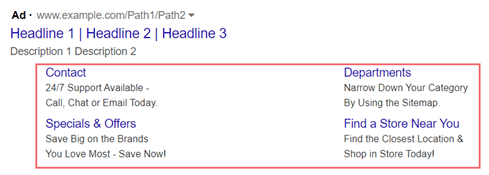
Google will show a maximum of four sitelinks with your ad and Microsoft will show up to six. How much of your sitelink the end-user sees depends on multiple factors including the type of device they are using when they see your ad.
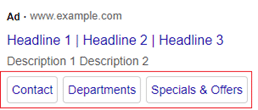
2. Callouts (Google and Microsoft)
Callout extensions are short, non-clickable, snippets of text — just 25 characters long — that highlight your business features and unique selling propositions. Callouts should be specific and give users more information such as “Free Delivery” or “24/7 Support.” Google may show up to ten callouts with your ad and Microsoft shows a maximum of four.

3. Structured Snippets (Google and Microsoft)
Structured snippets list extra information about a specific part of your business. You choose from a dropdown list of available headers and include a minimum of three to a maximum of ten related values.
The list of headers includes Amenities, Brands, Courses, Styles, Types, Destinations, and a handful more. For example, you might use the header “Types” and the values “Red Oak, Hard Maple, and White Pine” to let customers know about the types of wood you have available.
It is important to note that, unlike most ad extensions, structured snippets are not clickable. They are only used to provide visible information about the kinds of goods or services you are offering.

4. Call Extensions (Google and Microsoft)
Call extensions make it easy for searchers to call your business. Users simply click your phone number or a phone icon shown under your ad to be directly connected to your business. This is the only place a phone number can be displayed in your ad, so if you want to drive calls to your business it’s imperative that you include a call extension.
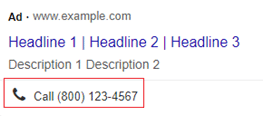
5. Location Extensions (Google and Microsoft)
Location extensions show the physical address of your business. Users can click to get further information such as a map to your location or the distance to your business.
This extension encourages in-store visits while making it easy to find your brick-and-mortar business. Location extensions on Google require a Google My Business (GMB) account; on Microsoft, they can be added manually.

6. Affiliate Location Extensions (Google)
Affiliate location extensions promote the business locations selling your product. Ads that show this extension help customers find nearby stores selling the searched product. These are only available on Google Ads and only to retail chains and auto dealers in select countries.
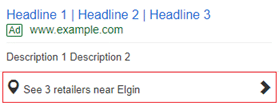
7. Price Extensions (Google and Microsoft)
Price extensions show searchers the price of your products or services alongside your ad. They consist of a header and short description (25 characters for each), price, and a final URL.
One of the neat features of this type of extension is that users can click on products and services directly from the price extension shown in your ad.

8. App Extensions (Google and Microsoft)
An app extension allows users to easily access and download your app. It consists of a 25-character clickable link text, a final URL, and is accompanied by your icon. When clicked, an app extension will take the user directly to the app download page in the app store for the device that they are using.

9. Promotion Extensions (Google and Microsoft)
Promotion extensions are used to highlight current sales and special offers that your business is running. These extensions are ideal for customers searching for the best price or a hot deal.
Promotion extensions can include a promo code, valid dates, and the occasion the sale is running for such as Easter, Halloween, Christmas, and others. This type of extension also features either a percent or monetary discount as well as a final URL to the page on your site that highlights the promotion.
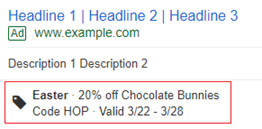
10. Image and Multi-Image Extensions (Google and Microsoft)
Image extensions allow you to include visually-appealing pictures underneath your ad. Image extensions are currently a beta in Google Ads and are only available to select advertisers.
In Microsoft, image extensions display a single image and multi-image extensions can display up to five images with your ad. It’s important to mention that multi-image extensions are only available in the U.S. and are in beta everywhere else.
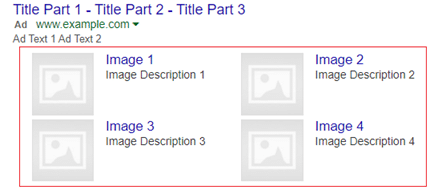
11. Seller Rating Extensions (Google)
Seller rating extensions show your GMB review rating out of five stars, the number of ratings the business has, and a qualifier such as price range or average delivery time if that data is available. Available only to advertisers who have their GMB linked to their Google Ads account, seller rating extensions are a great way to showcase positive reviews. These are only available in Google and there is no charge when clicked.

12. Review Extensions (Microsoft)
Review extensions display positive reviews, awards, or rankings from a reputable, third-party source. Clicking sends the user to the third-party review site, and not to a final URL of your choice. Similar to seller ratings, there’s no charge when clicked. Review extensions are only available in Microsoft and are served everywhere except in China.

13. Lead Form Extensions (Google)
Lead form extensions allow users to fill out and submit a form directly from your ad. Customers can engage and submit information such as their name, contact number, and email without ever leaving the search engine result page (SERP) or visiting your site. Lead forms are only available in select countries in Google but have proven to be powerful tools for gathering leads.
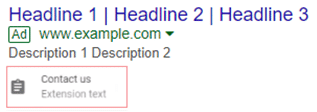
14. Action Extensions (Microsoft)
Action extensions are a list of preset call-to-action buttons that can be included with your ad copy. You choose from a list of 62 actions including “Shop Now,” “Download,” “Apply Now,” “Register,” “Learn More,” “Free Quote,” and many more. Action extensions are only available in Microsoft.

15. Filter Link Extensions (Microsoft)
Filter link extensions list additional information about your products or services. They look like structured snippets; you choose from a list of predefined headers and include 3-10 related values. The main difference is that these values are clickable and allow you to send users to specific pages. Filter link extensions are on Microsoft only and are new as of January 2021.

As a best practice, Google and Microsoft both recommend adding all the extensions that make sense for your business. Their sophisticated algorithms will use machine learning to select and show the extension that they feel will resonate with the searcher at that time.
Adding extensions into your marketing mix is an excellent way to add more value to your ads, take up SERP real estate, and increase your clickthrough rate. Make the most of your paid search efforts with ad extensions.








